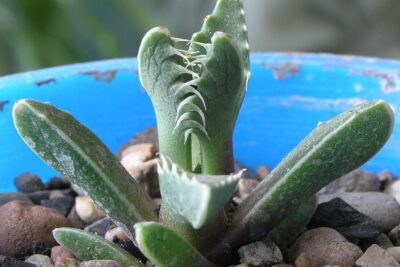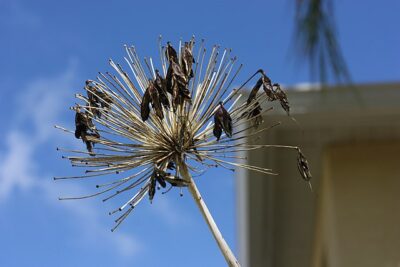
Reviving a Succulent with Root Rot: Best Methods for Recovery

Root rot is a common problem that succulent owners may encounter. Succulents are known for their ability to store water in their leaves and stems, making them drought-tolerant plants. However, if they are overwatered or planted in poorly draining soil, their roots can become waterlogged and develop rot. This can lead to a decline in the plant's health and, if left untreated, can even be fatal.
We will explore the best methods for reviving a succulent with root rot. We will discuss how to identify the signs of root rot, including yellowing or blackening of the leaves, mushy or discolored roots, and a foul smell. We will then delve into the steps you should take to save your succulent, such as removing the affected roots, letting the plant dry out, and replanting it in well-draining soil. Additionally, we will provide tips on preventing root rot in the future, such as adjusting your watering routine and choosing the right potting mix. By following these methods, you can give your succulent the best chance of recovery and ensure its long-term health and vitality.
- Remove the succulent from its pot
- Gently brush off any excess soil from the roots
- Trim away any mushy or blackened roots with clean scissors or shears
- Allow the succulent to dry for a few days to promote new root growth
- Repot the succulent in fresh, well-draining soil
- Water the succulent sparingly, allowing the soil to dry out between waterings
- Provide the succulent with bright, indirect light
- Avoid overwatering or keeping the succulent in overly humid conditions
- Monitor the succulent closely for signs of improvement or further deterioration
- Consider using a root hormone or succulent-specific fertilizer to encourage growth
- Frequently Asked Questions
Remove the succulent from its pot
If you suspect root rot in your succulent, the first step towards recovery is to carefully remove it from its pot. This allows you to assess the extent of the damage and take appropriate measures to save your plant.
Start by gently loosening the soil around the base of the succulent using your fingers or a small gardening tool. Once the soil is loose, carefully lift the plant out of the pot, taking care not to damage the roots further.
Note: If the root rot is severe and the roots are mushy or discolored, you may need to trim off the affected parts. However, be cautious not to remove too much healthy tissue.
Once the succulent is out of the pot, gently shake off any excess soil to get a better look at the roots. Inspect them closely for signs of rot, such as dark, mushy, or foul-smelling sections.
 Succulent Care: Treating Brown Spots and Disease
Succulent Care: Treating Brown Spots and DiseasePro tip: Healthy roots should be firm, plump, and light in color.
If you notice any root rot, it's essential to act promptly to prevent further damage to the plant. Below, we outline the best methods for recovery:
1. Cut away the affected roots
If you've identified sections of the roots that are clearly rotten, it's crucial to remove them to prevent the spread of decay. Using a clean pair of sterilized scissors or pruning shears, carefully trim off the affected roots, cutting just above the healthy tissue.
Remember: Always sanitize your cutting tools to minimize the risk of spreading any potential diseases.
2. Allow the roots to dry
After removing the affected roots, it's essential to allow the remaining healthy roots to dry out. Place the succulent in a dry and well-ventilated area for a few days or until the cuts have calloused over.
Tip: Avoid direct sunlight during this period, as it may cause further stress to the plant.
3. Repot the succulent in fresh soil
Once the roots have dried and calloused, it's time to repot your succulent in fresh, well-draining soil. Choose a pot that provides adequate drainage and fill it with a succulent-specific soil mix or a mixture of perlite and potting soil.
 How to Remove White Mold From Succulents: Essential Tips and Tricks
How to Remove White Mold From Succulents: Essential Tips and TricksPlace the succulent in the center of the pot and gently fill in the gaps with the soil mixture, ensuring the roots are adequately covered. Avoid compacting the soil too tightly, as this can impede drainage.
Remember: Water sparingly after repotting, as the plant needs time to recover and establish new roots.
By following these steps, you give your succulent the best chance at recovering from root rot and thriving once again. Remember to monitor the plant closely in the weeks following repotting and adjust your care routine as needed.
Gently brush off any excess soil from the roots
If your succulent is suffering from root rot, the first step in the recovery process is to gently brush off any excess soil from the roots. Use a soft brush or your fingers to carefully remove the soil without causing any further damage to the roots.
Be sure to handle the roots with care, as they can be delicate and easily damaged. Removing the excess soil will help you get a better look at the condition of the roots and assess the extent of the root rot.
Trim away any black or mushy roots
Once you have cleared away the excess soil, carefully examine the roots for any signs of black or mushy areas. These are indications of severe root rot and should be removed to prevent further damage to the plant.
 Understanding the Causes of Spider Web-Like Growths in Succulents
Understanding the Causes of Spider Web-Like Growths in SucculentsUsing a clean and sharp pair of scissors or pruning shears, carefully trim away the affected roots. Make clean cuts above the damaged areas, removing the unhealthy portions while leaving behind healthy root sections.
Be cautious not to cut into any healthy roots, as this can weaken the plant's ability to absorb nutrients and water.
Allow the roots to dry before repotting
After trimming away the damaged roots, it is crucial to allow them to dry before repotting the succulent. Placing the roots in a well-ventilated area for a few days will help them heal and prevent the spread of any remaining rot.
Avoid exposing the roots to direct sunlight during the drying process, as this can cause further damage. Instead, find a shaded spot with good airflow to promote healing.
Once the roots are completely dry, you can proceed with repotting the succulent using fresh and well-draining soil.
Water the succulent sparingly
When your succulent is recovering from root rot, it is essential to adjust your watering routine to prevent further stress on the plant. Overwatering can exacerbate root rot and hinder the recovery process.
Instead, water the succulent sparingly, allowing the soil to dry out partially between each watering. This will help promote healthy root growth while preventing the development of excessive moisture that can lead to rot.
 Effective Solutions for Eliminating Mealy Bugs on Succulent Plants
Effective Solutions for Eliminating Mealy Bugs on Succulent PlantsRemember to always check the moisture levels in the soil before watering and adjust accordingly based on the specific needs of your succulent.
Provide adequate sunlight and proper care
To support the recovery of your succulent, it is crucial to provide it with adequate sunlight and proper care. Most succulents thrive in bright, indirect light, so find a spot near a window where they can receive a few hours of sunlight each day.
Additionally, ensure that your succulent is placed in a well-ventilated area to prevent the development of excessive humidity. Proper air circulation will help the roots recover and prevent the recurrence of root rot.
Lastly, continue to monitor your succulent closely for any signs of stress or further issues. Adjust your care routine as needed and be patient, as it may take some time for the plant to fully recover.
Reviving a succulent with root rot is possible with proper care and attention. By gently brushing off excess soil, trimming away damaged roots, allowing for drying time, adjusting watering habits, and providing adequate sunlight and care, you can help your succulent recover and thrive once again.
Remember, prevention is always better than cure when it comes to root rot, so ensure you provide your succulents with well-draining soil, proper watering techniques, and suitable growing conditions to help prevent this issue in the future.
Trim away any mushy or blackened roots with clean scissors or shears
 Understanding the Factors behind Succulent Death Blooms
Understanding the Factors behind Succulent Death BloomsIf you notice that your succulent is suffering from root rot, it is crucial to take immediate action to save your plant. One of the first steps in the recovery process is to trim away any mushy or blackened roots. To do this, make sure to use clean scissors or shears to prevent the spread of any potential infections.
Allow the succulent to dry for a few days to promote new root growth
When a succulent is suffering from root rot, it is crucial to take immediate action to revive it and prevent further damage. One of the first steps in the recovery process is allowing the succulent to dry out for a few days. This will help promote new root growth and prevent the spread of rot.
Here are some best methods to follow when drying out a succulent with root rot:
1. Remove the succulent from its pot
Start by carefully removing the succulent from its pot. Gently loosen the soil around the roots and shake off any excess moisture. Be cautious not to damage the remaining healthy roots during this process.
2. Inspect the roots
Once the succulent is out of its pot, carefully examine the roots for any signs of rot. Healthy roots should be firm and white, while rotting roots may appear mushy, discolored, or have a foul odor.
3. Trim off the rotting roots
Using clean and sharp scissors or pruning shears, trim off any rotting roots. Make sure to cut back to healthy tissue to prevent the spread of the rot. It is better to remove more rotting roots than to leave any behind.
 Can a Death Bloom Succulent Be Saved or is it Too Late?
Can a Death Bloom Succulent Be Saved or is it Too Late?4. Let the succulent air dry
After removing the rotting roots, place the succulent in a well-ventilated area away from direct sunlight. Allowing the plant to air dry for a few days will help the remaining healthy roots to callus over and prevent further rotting.
5. Replant in well-draining soil
Once the succulent has dried out, it is time to replant it in fresh, well-draining soil. Choose a pot with drainage holes to prevent water from pooling at the bottom. Use a succulent-specific soil mix or make your own by combining regular potting soil with perlite or coarse sand for improved drainage.
6. Water sparingly
After replanting, it is important to water the succulent sparingly. Overwatering can lead to root rot, so only water when the soil is completely dry. Succulents are adapted to survive in arid conditions, so they prefer infrequent but deep watering.
7. Gradually reintroduce sunlight
Once the succulent has been replanted and watered, gradually reintroduce it to sunlight. Start by placing it in a location with indirect light and gradually move it to a spot with more direct sunlight over a few weeks. This will help the succulent adjust and prevent sunburn.
By following these steps and providing the right care, you can successfully revive a succulent with root rot. Remember to monitor the plant closely and make adjustments as needed to ensure its full recovery.
Repot the succulent in fresh, well-draining soil
If your succulent is suffering from root rot, one of the best methods for recovery is to repot it in fresh, well-draining soil. This step is crucial as it helps to remove any excess moisture that may have contributed to the root rot in the first place.
To repot your succulent, start by gently removing it from its current pot. Carefully loosen the soil around the roots, being cautious not to cause further damage. Once the succulent is free from its old pot, inspect the roots for any signs of rot or mushiness. Trim away any affected roots using a clean, sharp pair of scissors or pruning shears. It is important to make clean cuts to prevent further infection.
 Understanding the Cause: Why is My Succulent's Base Turning White?
Understanding the Cause: Why is My Succulent's Base Turning White?After trimming the roots, prepare a new pot with fresh, well-draining soil. Choose a pot with drainage holes to ensure proper water flow and prevent future root rot. Fill the pot about halfway with the new soil, creating a small mound in the center. Place the succulent on top of the mound, spreading out its roots evenly.
Next, carefully fill in the remaining space around the succulent with the fresh soil, gently pressing it down to secure the plant in place. Be mindful not to over-pack the soil, as compacted soil can hinder drainage and lead to additional moisture-related issues.
Once you have successfully repotted your succulent, give it a thorough watering to help settle the soil and promote root establishment. However, it is crucial to be mindful of the watering needs of your specific succulent species, as overwatering can contribute to root rot.
Place your newly repotted succulent in a well-lit area, but avoid direct sunlight, especially during the recovery period. Monitor the plant closely and make any necessary adjustments to its care routine, such as adjusting watering frequency or providing supplemental light.
By repotting your succulent in fresh, well-draining soil, you are giving it a fresh start and providing the optimal conditions for recovery from root rot.
Water the succulent sparingly, allowing the soil to dry out between waterings
When dealing with a succulent that has root rot, it is crucial to adjust your watering routine. Overwatering is often the leading cause of root rot in succulents, as their roots are not adapted to sitting in wet soil for extended periods.
To revive a succulent with root rot, it is essential to water it sparingly. Allow the soil to dry out completely between waterings. This will help prevent further damage to the already weakened roots and encourage new healthy root growth.
 Causes of Holes in Succulent Leaves: A Comprehensive Guide
Causes of Holes in Succulent Leaves: A Comprehensive GuideMethods for watering a succulent with root rot:
- Stick to a strict watering schedule: Create a watering schedule based on the specific needs of your succulent. Generally, succulents require watering every 1-2 weeks, but this can vary depending on the climate and the type of succulent. Avoid watering on a whim or when the soil simply "looks" dry.
- Use the "soak and dry" method: When watering your succulent, give it a thorough soak, ensuring that the water reaches the roots. Wait until the soil is completely dry before watering again. This method helps prevent overwatering and allows the roots to receive adequate moisture without sitting in wet soil.
- Choose the right soil: Opt for a well-draining soil mix specifically formulated for succulents. This type of soil allows excess water to drain quickly, reducing the risk of root rot. Avoid using heavy or moisture-retaining soils, as they can trap water around the roots.
By adjusting your watering routine and following these methods, you can give your succulent the best chance of recovering from root rot. Remember, patience is key during this process as it may take some time for the succulent to show signs of improvement.
Provide the succulent with bright, indirect light
When reviving a succulent with root rot, one of the most important steps is to provide it with bright, indirect light. This will help the plant recover and grow new healthy roots.
Succulents thrive in natural light, but intense sunlight can further stress a plant that is already weakened by root rot. Therefore, it is crucial to place the succulent in an area where it can receive plenty of light without direct exposure to the sun's rays.
A windowsill or a spot near a well-lit area in your home can be an ideal location for the succulent. If natural light is limited, you can also use artificial grow lights to provide the necessary brightness.
Remember to rotate the succulent periodically to ensure even distribution of light, as this will promote symmetrical growth and prevent the plant from leaning towards the light source.
By providing the succulent with bright, indirect light, you are giving it the best chance to recover and regain its vitality.
 Safe and Kid-Friendly: Non-Toxic Succulents for Pets and Children
Safe and Kid-Friendly: Non-Toxic Succulents for Pets and ChildrenAvoid overwatering or keeping the succulent in overly humid conditions
One of the main causes of root rot in succulents is overwatering or keeping them in overly humid conditions. Succulents are adapted to arid environments and have specialized leaves and stems that store water. Therefore, they are not accustomed to excessive moisture.
To prevent root rot, it is crucial to avoid overwatering your succulent. Only water the plant when the soil is completely dry. You can check the moisture level by sticking your finger about an inch into the soil - if it feels dry, it's time to water. Additionally, make sure that the pot has proper drainage holes to allow excess water to escape.
Signs of root rot in succulents
Identifying root rot in succulents can be tricky as the symptoms may not be immediately obvious. However, there are a few signs to look out for:
- Yellowing or wilting leaves: If you notice the lower leaves of your succulent turning yellow, mushy, or wilting, it may be a sign of root rot.
- Foul odor: A foul smell emanating from the soil is a clear indication of root rot. Healthy succulents should not have an unpleasant odor.
- Soft or blackened roots: Gently remove the succulent from its pot and inspect the roots. If they appear soft, mushy, or blackened, root rot is likely the culprit.
Steps to revive a succulent with root rot
If you suspect your succulent has root rot, don't panic. With proper care and attention, you can nurse it back to health. Here are the steps to revive your succulent:
- Remove the affected roots: Gently remove the succulent from its pot and carefully trim away any soft, mushy, or blackened roots. Be cautious not to damage the healthy roots.
- Allow the roots to dry: After removing the affected roots, let the remaining healthy roots dry for a few days. This will help prevent further rotting and allow the plant to recover.
- Repot the succulent: Once the roots have dried, prepare a new pot with well-draining soil suitable for succulents. Place the succulent in the new pot and carefully fill in the gaps with soil, ensuring the roots are covered but not buried too deeply.
- Water sparingly: After repotting, it's important to water the succulent sparingly. Wait until the soil is completely dry before watering again, and be mindful not to overwater.
- Provide proper light and temperature: Succulents thrive in bright, indirect sunlight. Place your revived succulent in a location with adequate light, but avoid direct sunlight, especially during the hottest hours of the day. Additionally, ensure the temperature is suitable for the specific succulent species.
- Monitor and adjust care: Keep a close eye on your succulent and adjust your care routine as needed. Watch for signs of improvement, such as new growth or healthy leaves, and make any necessary adjustments to ensure the plant's well-being.
By following these steps and providing the right conditions, you can successfully revive a succulent with root rot and help it regain its health and vitality.
Monitor the succulent closely for signs of improvement or further deterioration
 Causes of Shriveled and Wrinkled Leaves in Succulents
Causes of Shriveled and Wrinkled Leaves in SucculentsReviving a succulent with root rot can be a delicate process, requiring careful monitoring and attention. After implementing the necessary recovery methods, it's important to keep a close eye on the plant's progress. By observing the succulent closely, you can gauge whether it is responding positively to the treatment or if further action is needed.
Here are some key signs to look for:
- New growth: Keep an eye out for the emergence of new leaves or stems. This indicates that the succulent is recovering and regenerating.
- Firm and plump leaves: As the succulent recovers, its leaves should regain their turgidity and become firm to the touch. This is a positive indication of improved health.
- Root development: Check the roots of the succulent for signs of new growth. Healthy roots should appear white or light-colored, while rotting roots may be mushy, dark, or foul-smelling.
- Improved overall appearance: A recovering succulent should show general signs of improvement, such as a more vibrant color, increased fullness, and a healthier overall appearance.
It's important to note that the recovery process can take time, and each succulent may respond differently. Some plants may show signs of improvement within a few weeks, while others may take several months to fully recover. Patience and consistent observation are key during this stage.
If, despite your best efforts, the succulent continues to deteriorate or shows no signs of improvement, it may be necessary to reassess the treatment methods or seek advice from a knowledgeable plant expert.
Remember, prevention is always better than cure when it comes to root rot. To avoid future issues, ensure proper drainage for your succulents, use well-draining soil, and avoid overwatering. By providing the right conditions and promptly addressing any signs of trouble, you can help your succulents thrive and prevent root rot from occurring in the first place.
Consider using a root hormone or succulent-specific fertilizer to encourage growth
When your beloved succulent is suffering from root rot, it's essential to take immediate action to revive it. One effective method to encourage growth and recovery is by using a root hormone or succulent-specific fertilizer.
A root hormone is a growth stimulant that helps speed up root development in plants. It contains auxins, which promote the formation of roots and enhance the overall health of the plant. When applied to a succulent with root rot, the root hormone can encourage the growth of healthy roots, replacing the damaged ones.
Similarly, using a succulent-specific fertilizer can provide the necessary nutrients to support the recovery process. Succulents have specific nutritional requirements, and using a fertilizer specially formulated for them ensures that they receive the right balance of nutrients to thrive.
Choosing the Right Root Hormone
When selecting a root hormone, opt for a gel or powder form that is easy to apply. Look for products that are specifically labeled for succulents or general use, as these are more likely to contain the necessary ingredients to promote root growth.
Before applying the root hormone, gently remove the succulent from its pot and carefully inspect the roots. Trim away any soft, mushy, or discolored roots, as these are signs of rot. Once the damaged roots are removed, lightly dust the cut ends with the root hormone powder or dip them into the gel, following the manufacturer's instructions.
After applying the root hormone, allow the succulent to dry for a day or two before replanting it in a well-draining potting mix. This waiting period allows the hormone to stimulate root growth and prepares the succulent for its new environment.
Using Succulent-Specific Fertilizer
When it comes to selecting a succulent-specific fertilizer, look for one with a balanced NPK (nitrogen, phosphorus, and potassium) ratio. Succulents typically require a fertilizer with a higher phosphorus content to promote root development and flowering.
Follow the manufacturer's instructions for dilution rates and frequency of application. Typically, it is recommended to fertilize succulents during their active growing season, which is usually spring and summer. Be cautious not to over-fertilize, as this can lead to fertilizer burn or nutrient imbalances.
Apply the fertilizer to the soil around the succulent, avoiding direct contact with the leaves or stem. Water the succulent lightly after fertilizing to ensure the nutrients are absorbed properly.
Remember to monitor your succulent's progress closely after using a root hormone or fertilizer. If you notice any signs of improvement, such as new growth or healthy roots, it's a positive indication that your succulent is on the path to recovery.
Frequently Asked Questions
1. What is root rot in succulents?
Root rot in succulents is a condition caused by overwatering or poor drainage, leading to fungal or bacterial infections that damage the roots.
2. How can I tell if my succulent has root rot?
You can identify root rot in succulents by observing wilting, yellowing leaves, mushy or blackened roots, and an unpleasant odor coming from the soil.
3. Can a succulent with root rot be saved?
Yes, a succulent with root rot can be saved if caught early. By removing the affected roots, improving drainage, and adjusting watering habits, the plant can recover.
4. What are the best methods for reviving a succulent with root rot?
To revive a succulent with root rot, remove the plant from its pot, trim away the affected roots, let it dry for a few days, repot in fresh well-draining soil, and adjust watering frequency to prevent future rot.
If you want to read more articles similar to Reviving a Succulent with Root Rot: Best Methods for Recovery, you can visit the Pests and Diseases category.






You Must Read